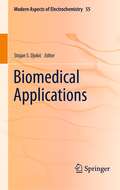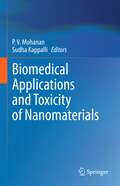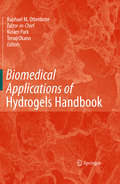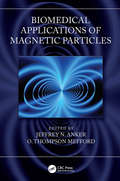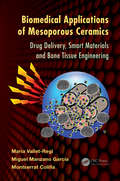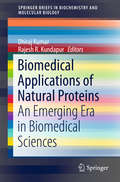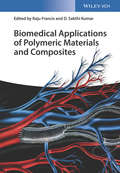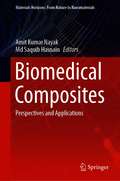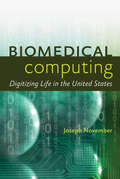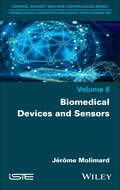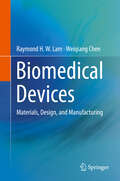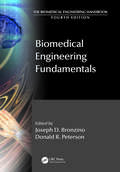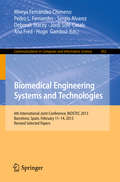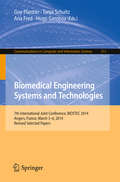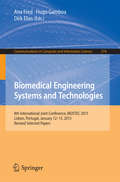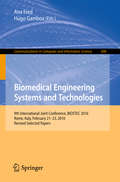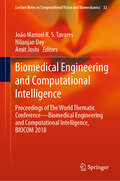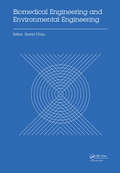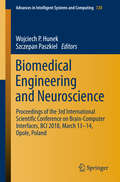- Table View
- List View
Biomechatronics in Medical Rehabilitation: Biomodelling, Interface, And Control
by Shane S. Q. Xie Wei MengThis book focuses on the key technologies in developing biomechatronic systems for medical rehabilitation purposes. It includes a detailed analysis of biosignal processing, biomechanics modelling, neural and muscular interfaces, artificial actuators, robot-assisted training, clinical setup/implementation and rehabilitation robot control. Encompassing highly multidisciplinary themes in the engineering and medical fields, it presents researchers' insights into the emerging technologies and developments that are being utilized in biomechatronics for medical purposes. Presenting a detailed analysis of five key areas in rehabilitation robotics: (i) biosignal processing; (ii) biomechanics modelling; (iii) neural and muscular interfaces; (iv) artificial actuators and devices; and (v) the use of neurological and muscular interfaces in rehabilitation robots control, the book describes the design of biomechatronic systems, the methods and control systems used and the implementation and testing in order to show how they fulfil the needs of that specific area of rehabilitation. Providing a comprehensive overview of the background of biomechatronics and details of new advances in the field, it is especially useful for researchers, academics and graduates new to the field of biomechatronics engineering, and is also of interest to researchers and clinicians in the medical field who are not engineers.
Biomedical Applications (Modern Aspects of Electrochemistry #55)
by Stojan S. DjokićVarious metallic or non-metallic surfaces are frequently treated by elewctrochemical methods (e.g. electrodeposition, electroless deposition, anodization, passivation, etc.) in order to achieve a desirable property important for biomedical applications. Applications include orthopedic or dental implants, dressings for wound healing and different skin diseases, surfaces for the prevention of bio-film formation of corrosion inhibition in biological media. The aim of this issue of Modern Aspects of Electrochemistry is to review the latest developments of the surface treatments for biomedical applications in relation to electrochemical science and technology. This new volume of Modern Aspect of Electrochemistry brings to the scientists, engineers and students summarized results and new concepts of surface treatments for the biomedical applications which may have significant influence for the future practical applications.
Biomedical Applications and Toxicity of Nanomaterials
by P. V. Mohanan Sudha KappalliThis book covers the recent trends on the biological applications of nanomaterials, methods for their preparation, and techniques for their characterization. Further, the book examines the fundamentals of nanotoxicity, methods to assess the toxicity of engineered nanomaterials, approaches to reduce toxicity during synthesis. It also provides an overview of the state of the art in the application of Artificial intelligence-based methodologies for evaluation of toxicity of drugs and nanoparticles. The book further discusses nanocarrier design, routes of various nanoparticle administration, nano based drug delivery systems, and the toxicity challenges associated with each drug delivery method. It presents the latest advances in the interaction of nanoparticles with the cellular environment and assess nanotoxicity of these engineered nanoparticles. The book also explores the comparative and mechanistic genotoxicity assessment of the nanomaterials. This book is useful source of information for industrial practitioners, policy makers, and other professionals in the fields of toxicology, medicine, pharmacology, food, and drugs.
Biomedical Applications of Hydrogels Handbook
by Teruo Okano Kinam Park Raphael M. Ottenbrite Nicholas A. PeppasHydrogels are networks of polymer chains which can produce a colloidal gel containing over 99 per cent water. The superabsorbency and permeability of naturally occurring and synthetic hydrogels give this class of materials an amazing array of uses. These uses range from wound dressings and skin grafts to oxygen-permeable contact lenses to biodegradable delivery systems for drugs or pesticides and scaffolds for tissue engineering and regenerative medicine. Biomedical Applications of Hydrogels Handbook provides a comprehensive description of this diverse class of materials, covering both synthesis and properties and a broad range of research and commercial applications. The Handbook is divided into four sections: Stimuli-Sensitive Hydrogels, Hydrogels for Drug Delivery, Hydrogels for Tissue Engineering, and Hydrogels with Unique Properties. Key Features: Provides comprehensive coverage of the basic science and applications of a diverse class of materials Includes both naturally occurring and synthetic hydrogels Edited and written by world leaders in the field.
Biomedical Applications of Magnetic Particles
by Jeffrey N. Anker O. Thompson MeffordBiomedical Applications of Magnetic Particles discusses fundamental magnetic nanoparticle physics and chemistry and explores important biomedical applications and future challenges. The first section presents the fundamentals of the field by explaining the theory of magnetism, describing techniques to synthesize magnetic particles, detailing methods to characterize magnetic particles, and quantitatively describing the applied magnetic forces, torques, and the resultant particle motions. The second section describes the wide range of biomedical applications, including chemical sensors, cellular actuators, drug delivery, magnetic hyperthermia, magnetic resonance imaging contrast enhancement, and toxicity. Additional key features include: Covers both introduction to physics and characterization of magnetic nanoparticles and the state of the art in biomedical applications Authoritative reference for scientists and engineers for all new or old to the field Describes how the size of magnetic nanoparticles affects their magnetic properties, colloidal properties, and biological properties. Written by a team of internationally respected experts, this book provides an up-to-date authoritative reference for scientists and engineers.
Biomedical Applications of Mesoporous Ceramics: Drug Delivery, Smart Materials and Bone Tissue Engineering
by María Vallet-Regí Miguel Manzano García Montserrat ColillaDevelopments in mesoporous ceramics in drug delivery, nanomedicine, and bone tissue regeneration have opened promising developments in biomedical research, many applicable in the clinic in the near future. Due to the ability to fine-tune the physicochemical properties of these materials, the field has experienced an impressive burst in the number o
Biomedical Applications of Natural Proteins: An Emerging Era in Biomedical Sciences (SpringerBriefs in Biochemistry and Molecular Biology)
by Dhiraj Kumar Rajesh R. KundapurThis book is intended as a reference guide for graduate students, postgraduate students and researchers with a basic knowledge of protein chemistry who would like to know more about the biomedical applications of natural proteins to promote healthier lives. The book is divided into ten chapters, each of which explains different natural proteins and their established biomedical applications. The first chapter extensively deals with protein based natural fibers and provides an overview of all protein based fibers currently available. In turn, chapter two mainly focuses on the biomedical applications of a special class of proteins called Heat Shock Proteins; the biomedical applications of silkworm pupae proteins are dealt in chapter three. Chapter four examines an interesting use of Eri silk fibroin as a biomaterial for Tissue Engineering, while chapter five discusses the key experimental details involved in converting Tasar silk sericin into self-assembled nanoparticles. Chapter six offers brief descriptions of bioactive proteins with respect to their sources, synthesis and applications. Chapter seven is dedicated to Interleukine-8 and its role in human life, while chapter eight addresses the importance of natural proteins in infectious diseases. Chapter nine explores the issue of excess intake of dietary proteins and its adverse effects, and finally, chapter ten discusses the efficiency of drug delivery systems made up of gelatin nanocomposites. The book is above all intended as a valuable resource for students and researchers alike, sparking their curiosity with regard to the applications of natural proteins and motivating them to focus their own energies on the discovery or identification of additional natural proteins for diverse biomedical uses.
Biomedical Applications of Polymeric Materials and Composites
by D. Sakthi Kumar Raju FrancisWith its content taken from only the very latest results, this is an extensive summary of the various polymeric materials used for biomedical applications. Following an introduction listing various functional polymers, including conductive, biocompatible and conjugated polymers, the book goes on to discuss different synthetic polymers that can be used, for example, as hydrogels, biochemical sensors, functional surfaces, and natural degradable materials. Throughout, the focus is on applications, with worked examples for training purposes as well as case studies included. The whole is rounded off with a look at future trends.
Biomedical Applications of Polymeric Nanofibers (Advances in Polymer Science #246)
by Rangasamy Jayakumar Shantikumar NairMultiscale Fibrous Scaffolds in Regenerative Medicine, by Sowmya Srinivasan, R. Jayakumar, K. P. Chennazhi, Erica J. Levorson, Antonios G. Mikos and Shantikumar V. Nair; Stem Cells and Nanostructures for Advanced Tissue Regeneration, by Molamma P. Prabhakaran, J. Venugopal, Laleh Ghasemi-Mobarakeh, Dan Kai Guorui Jin and Seeram Ramakrishna; Creating Electrospun Nanofiber-Based Biomimetic Scaffolds for Bone Regeneration, by Eleni Katsanevakis, Xuejun Wen and Ning Zhang; Synthetic/Biopolymer Nanofibrous Composites as Dynamic Tissue Engineering Scaffolds, by J. A. Kluge and R. L. Mauck; Electrospun Fibers as Substrates for Peripheral Nerve Regeneration, by Jörg Mey, Gary Brook, Dorothée Hodde and Andreas Kriebel; Highly Aligned Polymer Nanofiber Structures: Fabrication and Applications in Tissue Engineering, by Vince Beachley, Eleni Katsanevakis, Ning Zhang, Xuejun Wen; Electrospinning of Biocompatible Polymers and Their Potentials in Biomedical Applications, by Pitt Supaphol, Orawan Suwantong, Pakakrong Sangsanoh, Sowmya Srinivasan, Rangasamy Jayakumar and Shantikumar V. Nair; Electrospun Nanofibrous Scaffolds-Current Status and Prospects in Drug Delivery, by M. Prabaharan, R. Jayakumar and S. V. Nair.; Biomedical Applications of Polymer/Silver Composite Nanofibers, by R. Jayakumar, M. Prabaharan, K. T. Shalumon, K. P. Chennazhi and S. V. Nair.-
Biomedical Composites: Perspectives and Applications (Materials Horizons: From Nature to Nanomaterials)
by Amit Kumar Nayak Md Saquib HasnainThis book provides an overview of biocomposite chemistry, chemical modifications, characterization and applications in biomedicine, with emphasis on recent advances in the field. Authored by experts, the chapters discuss the design, development and selection of biomedical composites for a particular therapeutic application, as well as providing insight into the regulatory and clinical aspects of biomedical composite use. While this book is primarily intended for scientists from the fields of medical, pharmaceutical, biotechnological and biomedical engineering, it is also useful as an advanced text for students and research scholars.
Biomedical Computing: Digitizing Life in the United States (The Johns Hopkins University Studies in Historical and Political Science #130)
by Joseph A. NovemberWinner of the Computer History Museum Prize of the Special Interest Group: Computers, Information, and SocietyImagine biology and medicine today without computers. What would laboratory work be like if electronic databases and statistical software did not exist? Would disciplines like genomics even be feasible if we lacked the means to manage and manipulate huge volumes of digital data? How would patients fare in a world absent CT scans, programmable pacemakers, and computerized medical records?Today, computers are a critical component of almost all research in biology and medicine. Yet, just fifty years ago, the study of life was by far the least digitized field of science, its living subject matter thought too complex and dynamic to be meaningfully analyzed by logic-driven computers. In this long-overdue study, historian Joseph November explores the early attempts, in the 1950s and 1960s, to computerize biomedical research in the United States.Computers and biomedical research are now so intimately connected that it is difficult to imagine when such critical work was offline. Biomedical Computing transports readers back to such a time and investigates how computers first appeared in the research lab and doctor's office. November examines the conditions that made possible the computerization of biology—including strong technological, institutional, and political support from the National Institutes of Health—and shows not only how digital technology transformed the life sciences but also how the intersection of the two led to important developments in computer architecture and software design. The history of this phenomenon has been only vaguely understood. November's thoroughly researched and lively study makes clear for readers the motives behind computerizing the study of life and how that technology profoundly affects biomedical research today.
Biomedical Data Analysis and Processing Using Explainable (Intelligent Systems Reference Library #222)
by Valentina E. Balas Deepak Gupta Ashish Khanna Aditya KhampariaThe book discusses Explainable (XAI) and Responsive Artificial Intelligence (RAI) for biomedical and healthcare applications. It will discuss the advantages in dealing with big and complex data by using explainable AI concepts in the field of biomedical sciences. The book explains both positive as well as negative findings obtained by explainable AI techniques. It features real time experiences by physicians and medical staff for applied deep learning based solutions. The book will be extremely useful for researchers and practitioners in advancing their studies.
Biomedical Devices and Sensors
by Jérôme MolimardMonitoring the human body is a key element of digital health science. Low-cost sensors derived from smartphones or smartwatches may give the impression that sensors are readily available; however, to date, very few of them are actually medical devices. Designing medical devices requires us to undertake a specific approach demanding special skills, as it concerns the integrity of the human body. The process is tightly framed by state regulations in order to ensure compliance with quality assessment, risk management and medical ethics requirements. This book aims to give biomedical students an overview on medical devices design. It firstly gives a historical and economical approach, then develops key elements in medical device design with reference to EU and US regulations, and finally describes sensors for the human body. The clinical approach is presented as the central element in medical device qualification and this offers a perspective on the use of numerical simulation, particularly since its continued growth in the USA; despite the fact that the approach is strictly limited by regulations.
Biomedical Devices: Materials, Design, and Manufacturing
by Weiqiang Chen Raymond H. LamThis textbook provides essential knowledge for biomedical product development, including material properties, fabrication processes and design techniques for different applications, as well as process design and optimization. This book is multidisciplinary and readers can learn techniques to apply acquired knowledge for various applications of biomedical design. Further, this book encourages readers to discover and convert newly reported technologies into products and services for the future development of biomedical applications. This is an ideal book for upper-level undergraduate and graduate students, engineers, technologists, and researchers working in the area of biomedical engineering and manufacturing.This book also:Provides a comprehensive set of fundamental knowledge for engineering students and entry level engineers to design biomedical devicesOffers a unique approach to manufacturing of biomedical devices by integrating and formulating different considerations in process design tasks into optimization problemsProvides a broad range of application examples to guide readers through the thinking process of designing and manufacturing biomedical devices, from basic understanding about the requirements and regulations to a set of manufacturing parameters
Biomedical Electronics, Noise Shaping ADCs, and Frequency References: Advances in Analog Circuit Design 2022
by Kofi A. A. Makinwa Andrea Baschirotto Pieter HarpeThis book is based on the 18 tutorials presented during the 30th workshop on Advances in Analog Circuit Design. Expert designers present readers with information about a variety of topics at the frontier of analog circuit design, with specific contributions focusing on analog circuits for machine learning, current/voltage/temperature sensors, and high-speed communication via wireless, wireline, or optical links. This book serves as a valuable reference to the state-of-the-art, for anyone involved in analog circuit research and development.
Biomedical Engineering Fundamentals (The Biomedical Engineering Handbook, Fourth Edition)
by Joseph D. Bronzino Donald R. PetersonKnown as the bible of biomedical engineering, The Biomedical Engineering Handbook, Fourth Edition, sets the standard against which all other references of this nature are measured. As such, it has served as a major resource for both skilled professionals and novices to biomedical engineering.Biomedical Engineering Fundamentals, the first volume of
Biomedical Engineering Principles
by Arthur B. Ritter Vikki Hazelwood Antonio Valdevit Alfred N. AscioneCurrent demand in biomedical sciences emphasizes the understanding of basic mechanisms and problem solving rather than rigid empiricism and factual recall. Knowledge of the basic laws of mass and momentum transport as well as model development and validation, biomedical signal processing, biomechanics, and capstone design have indispensable roles i
Biomedical Engineering Systems and Technologies: 6th International Joint Conference, BIOSTEC 2013, Barcelona, Spain, February 11-14, 2013, Revised Selected Papers (Communications in Computer and Information Science #452)
by Jordi Solé-Casals Ana Fred Mireya Fernández-Chimeno Pedro L. Fernandes Sergio Alvarez Deborah Stacey Hugo GamboaThis book constitutes the thoroughly refereed post-conference proceedings of the 6th International Joint Conference on Biomedical Engineering Systems and Technologies, BIOSTEC 2013, held in Barcelona, Spain, in February 2013. The 28 revised full papers presented were carefully reviewed and selected from a total of 392 submissions. The papers cover a wide range of topics and are organized in four general topical sections on biomedical electronics and devices; bioinformatics models, methods and algorithms; bio-inspired systems and signal processing; health informatics.
Biomedical Engineering Systems and Technologies: 7th International Joint Conference, BIOSTEC 2014, Angers, France, March 3-6, 2014, Revised Selected Papers (Communications in Computer and Information Science #511)
by Ana Fred Hugo Gamboa Guy Plantier Tanja SchultzThis book constitutes the thoroughly refereed post-conference proceedings of the 7th International Joint Conference on Biomedical Engineering Systems and Technologies, BIOSTEC 2014, held in Angers, France, in March 2014. The 25 revised full papers presented were carefully reviewed and selected from a total of 362 submissions. The papers cover a wide range of topics and are organized in topical sections on biomedical electronics and devices; bioimaging; bioinformatics models, methods and algorithms; bio-inspired systems and signal processing; health informatics.
Biomedical Engineering Systems and Technologies: 8th International Joint Conference, BIOSTEC 2015, Lisbon, Portugal, January 12-15, 2015, Revised Selected Papers (Communications in Computer and Information Science #574)
by Ana Fred Hugo Gamboa Dirk EliasThis book constitutes the thoroughly refereedpost-conference proceedings of the 8th International Joint Conference onBiomedical Engineering Systems and Technologies, BIOSTEC 2015, held in Lisbon,Portugal, in January 2015. The 27 revised full papers presented together with aninvited paper were carefully reviewed and selected from a total of 375submissions. The papers cover a wide range of topics and are organized in fourgeneral topical sections on biomedical electronics and devices;bioimaging; bioinformatics models,methods and algorithms; bio-inspired systems and signalprocessing; health informatics.
Biomedical Engineering Systems and Technologies: 9th International Joint Conference, BIOSTEC 2016, Rome, Italy, February 21–23, 2016, Revised Selected Papers (Communications in Computer and Information Science #690)
by Ana Fred Hugo GamboaThis book contains the best papers of the First International Joint Conference on B- medical Engineering Systems and Technologies (BIOSTEC 2008), organized by the Institute for Systems and Technologies of Information Control and Communication (INSTICC), technically co-sponsored by the IEEE Engineering in Medicine and Bi- ogy Society (EMB), ACM SIGART and the Workflow Management Coalition (WfMC), in cooperation with AAAI. The purpose of the International Joint Conference on Biomedical Engineering S- tems and Technologies is to bring together researchers and practitioners, including engineers, biologists, health professionals and informatics/computer scientists, int- ested in both theoretical advances and applications of information systems, artificial intelligence, signal processing, electronics and other engineering tools in knowledge areas related to biology and medicine. BIOSTEC is composed of three co-located conferences; each specializes in one of the aforementioned main knowledge areas, namely: * BIODEVICES (International Conference on Biomedical Electronics and - vices) focuses on aspects related to electronics and mechanical engineering, - pecially equipment and materials inspired from biological systems and/or - dressing biological requirements. Monitoring devices, instrumentation sensors and systems, biorobotics, micro-nanotechnologies and biomaterials are some of the technologies addressed at this conference.
Biomedical Engineering Technologies: Volume 1 (Methods in Molecular Biology #2393)
by Avraham Rasooly Houston Baker Miguel R. OssandonThis volume provides detailed technical protocols on current biosensors and imaging technologies and Chapters focus on optical, electrochemical, Quartz crystal microbalance (QCM) biosensors and on medical imaging technologies such as tomography, MRI, and NMR. Written in the format of the highly successful Methods in Molecular Biology series, each chapter includes an introduction to the topic, lists necessary materials and reagents, includes tips on troubleshooting and known pitfalls, and step-by-step, readily reproducible protocols. Authoritative and practical, Biomedical Engineering Technologies, Volume 1 provides technical details in descriptions of major technologies by experts in the field.
Biomedical Engineering and Computational Intelligence: Proceedings of The World Thematic Conference—Biomedical Engineering and Computational Intelligence, BIOCOM 2018 (Lecture Notes in Computational Vision and Biomechanics #32)
by João Manuel R. S. Tavares Nilanjan Dey Amit JoshiThis book reports on timely research at the interface between biomedical engineering and intelligence technologies applied to biology and healthcare. It covers cutting-edge methods applied to biomechanics and robotics, EEG time series analysis, blood glucose prediction models, among others. It includes ten chapters, which were selected upon a rigorous peer-review process and presented at the 1st World Thematic Conference - Biomedical Engineering and Computational Intelligence, BIOCOM 2018, held in London, United Kingdom, during October 30–31, 2018.
Biomedical Engineering and Environmental Engineering: Proceedings of the 2014 2nd International Conference on Biomedical Engineering and Environmental Engineering (ICBEEE 2014), December 24-25, 2014, Wuhan, China
by David ChanThis conference series is a forum for enhancing mutual understanding between Biomedical Engineering and Environmental Engineering field. This proceeding provides contributions from many experts representing industry and academic establishments worldwide. The researchers are from different countries and professional. The conference brought 
Biomedical Engineering and Neuroscience: Proceedings Of The 3rd International Scientific Conference On Brain-computer Interfaces, Bci 2018, March 13-14, Opole, Poland (Advances In Intelligent Systems And Computing #720)
by Wojciech P. Hunek Szczepan PaszkielThis edition of the volume ‘Advances in Intelligent Systems and Computing’ presents the proceedings of the 3rd International Scientific Conference BCI. The event was held at Opole University of Technology in Poland on 13 and 14 March 2018. Since 2014 the conference has taken place every two years at the University’s Faculty of Electrical Engineering, Automatic Control and Informatics. The conference focused on the issues relating to new trends in modern brain–computer interfaces (BCI) and control engineering, including neurobiology–neurosurgery, cognitive science–bioethics, biophysics–biochemistry, modeling–neuroinformatics, BCI technology, biomedical engineering, control and robotics, computer engineering and neurorehabilitation–biofeedback.In addition to paper presentations, the scientific program also included a number of practical demonstrations covering, for example, the on-line control of mobile robot and unmanned aerial vehicle using the BCI technology.

